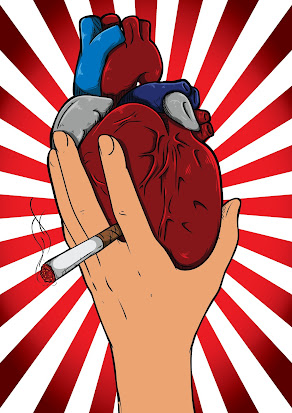Cardiovascular Health and Lifestyle Medicine🌿Part 3 - Smoking 🚭(4-minute read)
Today I am looking at the effect of smoking on the development of cardiovascular disease (CVD) and its management in Lifestyle medicine🌿. I want to put you in the driver’s 🚘 seat of the leading preventable cause of mortality (death) in the world- quitting smoking 🚭 of tobacco products. It is crucial to understand that for a smoker to give up, will be the best contribution to heart 💓 health they can make. Smoking is an addiction which can be more addictive than Heroin or alcohol 🍷 and is often more helpful to seek professional guidance for quitting. When coupled to the other pillars of Lifestyle medicine, it will lead to a potent blend of health benefits. I am going to tell you some of the effects smoking has on the heart and blood vessels:
The lining of the blood vessels is made up of endothelial cells, which is the gateway to the function of every single cell in your body. Smoking can lead to serious damage to these cells. Your heart supplies itself with nutrition before any other part of the body, and then the 100,000 KM of blood vessels supply the rest of the body, to over 30 trillion cells. There is no such thing as a safe number of tobacco products to smoke.
Smoking can lead to:
•
Heart attack
•
Sudden death
•
Danger of young females on
contraceptive medicines to increase their risk of coronary heart disease
•
Aneurysms (blood vessel
weakening accompanied by a ballooning effect, can lead to stroke)
•
Stroke, where a clot blocks a
blood vessel in the brain
•
Ischemic stroke
•
Peripheral vascular disease,
with loss of function in the arms and legs, can lead to ischemia (reduced
oxygen flow to tissues) and in critical ischemia, loss of limbs
•
Peripheral arterial disease,
which can lead to buttock, hip and limb pain
•
Emphysema (a lung disease) - The
lungs are vitally important for cardiovascular health
•
Clot formation and tissue death
•
Impotence
•
Inflammation throughout the
body
•
The number of Cancers related
to tobacco use exceed 40, in all parts of the body, including lung, throat,
tongue, trachea & bronchial
•
Serious adverse reactions
including failure of coronary heart disease operations
•
Blood pressure dysfunction
including hypertension (High Blood pressure)
•
Insulin resistance, which can
predispose you to the risk of cardiovascular disease
• Smoking can lead to Type 2 Diabetes (30%-40% higher risk)
Assistance 🤝🏼 for quitting is more likely to lead to long term abstinence from smoking. For instance, only 6.9% of people stop smoking out of 29% who try to quit with no assistance . This can lead to a feeling of failure and discourage further attempts. Considering the association of disease states listed above, it is delaying access to health improvements. If you stop smoking at the age of 30 years old, you add approximately 10 years to your life, or 3,650 days. These facts are no small matters. Even quitting at 60 years old can add up to 3 years to your life.
I urge you to seriously consider the benefits of
quitting, or to be the ambassador to your loved 💑🏻 ones if they
smoke. On a micro scale we can change the world together 🙌🏼.
7000 chemicals have been isolated in tobacco smoke, which directly enters the
alveoli cells of our lungs, an area of tissue the size of a football field⛹️♀️.
The most effective way of smoking cessation is to combine pharmaceutical intervention (when suitable) with counselling 🧑⚕️. Let's discuss this. Treatments available for quitting smoking include nicotine replacement therapy (NRT), prescription medications including Varenicline and Bupropion, and counselling. Counselling is one option I consider to be important in increasing the chance of long-term success. It can be individual counselling, group sessions or telephone counselling. Discuss it with your family doctor, who may be able to provide it or refer you for counselling with counsellors, Psychologists, or lifestyle medicine practitioners. There is a growing body of evidence which supports some internet based quit programs, including SMS message 📲 intervention, which can increase the quality of support for quit attempts.
Exercise 🚶🏽🏃🏽🚣🏽 🏄🏽🏊🏽⛹🏽🚴🏽🤸🏽is a valuable tool for decreasing the strength of cravings of nicotine withdrawal and is further improved when combined with exercise, better nutrition 🍓 🌽🍆, improved sleep 💤😴 time/quality, alcohol reduction or abstinence and higher quality social integration. Mindfulness 🧘♀️ 🧘 🧘♂️ based stress reduction and positive psychology ☯️ are also important and are a subject I will discuss in greater detail over the next few weeks.
I so often hear my patients tell me that they have tried but just cannot succeed. My experience demonstrates that most people can give up smoking. There are more people in the world who have given up smoking than the one billion people who are smoking presently. I know you can do it; a significantly large number of my patients are now non-smokers. You can look forward to:
•
Exponentially better health in
all areas of your life
•
Newfound energy levels
•
Less coughing
•
Less risk of chronic diseases
•
More money for other health promoting
activities
•
Less passive smoking risk to
the health of those who surround you
•
Empowerment from having control
over being free of the addiction to smoking tobacco products
•
Less time off work from
improvements in health
•
More effectiveness in your work
place
•
Less risk of work place
accidents
•
Less loved ones being exposed
to secondhand smoke
So, why don’t you consider moving to the preparation stage of quitting and set a date 🗓 to stop. If you feel this is too sudden, you can try the option of gradual reduction in tobacco use, which may certainly help reduce the experience of withdrawal symptoms. Have a careful think about the considerations that I have listed above. I know it can be done, I quit 33 years ago, the benefit to my health is unquestionable. Every day that you continue to smoke is a huge dilemma to the anatomy and physiology of your heart and blood vessel function, and most other parts of your body. The risk of stroke drops to that of a nonsmoker in 2-5 years. The risk of a heart attack can be reduced immediately by 50% compared to a smoker. You will reduce lung cancer risk by 50% in approximately 10 years. Do not underestimate your personal power 💪🏼, this is a must for your self-compassion 🙏🏼 and honoring the value you place on your life, for you and all of the people who dearly love 💞 you. See you next week.



Comments
Post a Comment